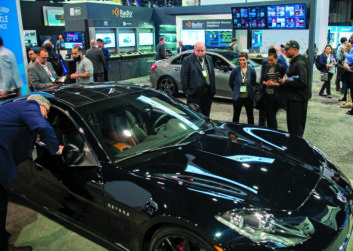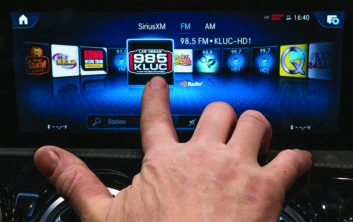
Credit: Jim Peck
We’ve all heard the hype about the connected car and how the internet will transform the dashboards of new cars coming soon to dealers everywhere. If you’ve been driving a car with a standard AM/FM radio or even a newer model using Bluetooth and a USB port for your smart devices, you’ve no doubt been wondering what the dashboard and radio will look like in your next car purchase.
It is evident that there are some dazzling new offerings on the market or coming soon. At this year’s NAB Show, the In Vehicle Experience pavilion attracted attention and a high volume of attendees; so before the spring show disappears entirely in our rear-view mirror, let’s summarize what we saw at that pavilion.
Four companies featured their own unique dashboard experiences inside a sleek new automobile in a simulated new car showroom setting. Show-goers were able to sit in most of the cars and get a hands-on demo with a rep explaining the new look and feel, plus all the available options. The entire Las Vegas radio market was on full-throttle, real-time display. In addition to the four-wheeled eye candy and radio demos, a speaker’s forum featured panels with experts discussing a range of topics related to the in-vehicle entertainment experience.
Certainly, the internet will play a major role in U.S. automobile dashboards very soon, as it’s already doing in Europe. But most broadcasters here are more concerned about how their radio stations of today will be accommodated in the dashboards of tomorrow’s new models.
VISUALS AND METADATA
Since RDS, perhaps the most important feature added to the car radio dashboard in recent years is the display of station logos, song titles and artists, album art, traffic report maps, commercial ad brand logos and other metadata related to the real-time programming. HD Radio was the first to implement an on-screen display of this program-associated data in car radios. SiriusXM has since followed that lead along with many streaming services now available in recently introduced IP-connected radio models.
One of the challenges for the car radio screens of tomorrow is presenting a consistent display of this information to the consumer. Xperi, the publicly held company that acquired DTS after the latter purchased the HD Radio platform from iBiquity, is positioning itself as the global metadata aggregator and integrator for all players. Those include Radio DNS, Arctic Palm, The Radio Experience, Jump2Go and others. By using IP connectivity in the vehicle, the DTS Connected Radio will integrate directly with broadcasters and those third-party platforms to deliver a consistent metadata experience around the world.
Dave Casey, program manager for the DTS Connected Radio project, told us, “Automakers are looking for a consistent user experience for their drivers when they are listening to the radio. Xperi is planning for the DTS Connected Radio to be the leading source of aggregated metadata, from broadcasters, to the manufacturers and their radio hardware suppliers.”
SOLVING THE MENU PROBLEM
Another major challenge that has confronted new car radio designers is how best to present an easy-to-use and intuitive menu of stations and services available to choose from in a specific listening area.

Credit: Jim Peck
Xperi has developed “Live Guide,” which actually uses two discrete radio tuners to make this happen.
The first tuner connects at startup, using the location to determine and list all available terrestrial radio services. Signals in the list are then sampled and validated in only one second, eliminating stations that are too weak or undetected.
The second tuner is the CREU (Connected Radio Evaluation Unit)-based reference radio. This is Xperi’s SDR developmental platform, which uses an integrated SDK-API software package to deliver a continuously scanning display menu of available stations on a touchscreen user interface.
Live Guide allows the user to see a clean list of all stations in their listening areas with metadata, including station logo, station name and what is playing on the station at that time. This feature demonstrates the importance of station metadata and how that impacts the radio listening experience.
Juan Galdamez, Xperi product marketing director, automotive and radio technologies, said, “If stations deliver rich metadata, radio designers can then use features like this to design compelling and intuitive radio experiences in future vehicles.”
NAB’s Pilot program has been using the DTS Connected Radio platform to show car radio manufacturers and the industry examples of the possibilities for car radios of tomorrow. Pilot has also used the DTS Connected Radio platform at several automotive hackathons around the country to create new radio listening experiences.
[A Look at the Mercedes-Benz Comand Infotainment System]
The main attraction in the pavilion was Xperi’s new widescreen HD Radio in a 2019 Mercedes A-Class sports car. This model did not integrate IP connectivity to include internet streams in the menu, but Casey told us this addition is under construction and should be implemented by next year.
The impressive new on-screen menu provides a panoply of options that goes far beyond any present-day car radio’s capabilities. As the user “tunes” the dial by finger scrolling, stations across the band are all displayed with call letters and frequencies, plus whatever metadata they’ve chosen to add like slogans, logos, format, song title/artist, album art, etc. A typical user not familiar with all the area’s choices will likely be more attracted to a station displaying the most eye candy and useful information, as opposed to one with nothing but call letters and frequency.
The intuitive menu allows the user to choose and lock in their favorite stations by touching the heart icon. They can also select filters to display only the formats and genres of interest during the scanning process.
Since it’s all software-driven, new features can be added as they are invented and become available.
Joe D’Angelo, Xperi senior vice president, radio, said, “As the DTS Connected Radio Platform evolves and achieves widespread acceptance, it will help to accelerate adoption and the manufacturing of a standardized integrated radio product for most all new cars.”
HD RADIO’S POSITIONING
Xperi’s dashboard demo in the 2019 Mercedes A-Class was a real eye-opener that showed off the power and capabilities of HD Radio. HD supplemental channel stations are automatically awarded a level playing field in the new scanning menu platform and are displayed in the same manner as their primary HD host stations, including the HD Artist Experience. That alone should breathe new life and value into HD2 and HD3 specialized formats that until now have struggled to generate significant ratings and revenue.

Credit: Jim Peck
This Mercedes also was equipped with HD Radio’s Emergency Alerts feature that will allow for EAS alerts to automatically turn on the radio in a time of need.
A quick note to the audio purists reading this: When HD Radio as well as SiriusXM and streaming radio services began ramping up, the audio quality was roundly criticized by many. The early codecs used back then have been upgraded and replaced. As with other first-generation technology rollouts, problems are addressed and bugs are flushed out. The HE-AAC with SBR algorithm variations used in today’s codecs have largely eliminated the degraded audio quality complaints associated with most digital and internet based services.
OTHER MARKET PLAYERS
While the Mercedes demonstration on the show floor did not include IP/internet integration this year, several others did.
A very flashy and very expensive ($130,000) black Karma Revero was showing a prototype DTS Connected Radio integration. Xperi worked with Karma to design an all-new radio experience with DTS Connected Radio, though due to technical issues, the demo shut down before the end of the show.
Audi unveiled a very impressive demonstration of its hybrid 4G-LTE internet connected radio with AM/FM integration. Audi appears to be in the lead with connected car technology, having introduced its first model in Europe almost three years ago. They plan to add their newest version of a continuous tuning, touch screen menu driven dial that integrates AM/FM, SiriusXM and the internet next year for U.S. model delivery.
By far, the most innovative feature of the Audi hybrid radio shown in a kiosk next to an Audi eTron was the simulated fail-over of the terrestrial FM reception to its internet stream as the FM signal became unusable. They call it “Service Following Online,” which uses special buffering to allow a seamless transition. The rep told us the Audi eTron, including the new radio, is available in Europe, and they are taking orders now. It’s priced around $75,000.
Audi, along with most of the European car radio manufacturers, is now using the UK-based Radio Player that hosts Radio DNS as the metadata integrator. Radio Player is a nonprofit group that had a rep and booth in the pavilion. They claim a presence in 11 European countries, with 80% of all German stations using the service, and came to the NAB Show hoping to sign up U.S.-based companies.
[Strategy Analytics Report Finds In-Car Terrestrial Radio at Risk]
General Motors partnered with Avis Car Rental in the pavilion, showing a new Buick Enclave SUV. The stock HD Radio demonstration featured the addition of a software app that emulates the DTS Connected Radio platform touchscreen, complete with the same look and feel as the real radio demo shown by Xperi in their booth. The software was developed by Open Path in collaboration with NAB Pilot.
Avis rents 600,000 cars in 180 countries worldwide. The new GM/Avis radio offering is targeted at “road warriors” who frequently rent a car and travel in unfamiliar cities and are looking for radio stations based on favorite formats and genres. A trial for real consumers driving Avis vehicles is slated for the third quarter of this year in Kansas City, Mo.
MINIMAL PHYSICAL INTERACTION
As mentioned, the In Vehicle Experience pavilion included panel discussions by experts on pertinent topics. Radio World’s Paul McLane moderated one of the more fascinating panels; it tackled the question of what should be the most pressing priorities for the connected car radio of the future.
John Vermeer of iHeartMedia said, “The connected car radio dashboard interface must be simple but fast to deliver desired content to the user with minimal physical interaction.” With that in mind, James Buczkowski of Ford Motor Company cited voice command interaction, à la electronic assistants like Alexa and Cortana, as perhaps the best way to control the connected car radio going forward.
Many kinds of consumer devices that use voice commands are becoming popular and widespread. Buczkowski suggested, “Voice commands eliminate the need for multiple button pushes to get what the user wants quickly.” And it reduces driver distraction — no messing with the radio instead of looking at the road ahead.
So where do we stand with the internet connected car radio rollout schedule? We’re all wondering how soon the impressive new receivers shown at the NAB Show will arrive in new car company showrooms. If you live in Europe, you can buy one now. U.S. consumers will have to wait until at least sometime next year. At the spring show, we learned that LG is now building a connected car radio for a major U.S. car company to be unveiled in 2021 models.
However the connected car with internet integration shapes the car radio experience of the future, it is still safe to conclude that over-the-air terrestrial and satellite radio reception with augmentation of internet streams and interactivity will be the most efficient, reliable and diversified audio entertainment platform available to consumers for many years to come.







